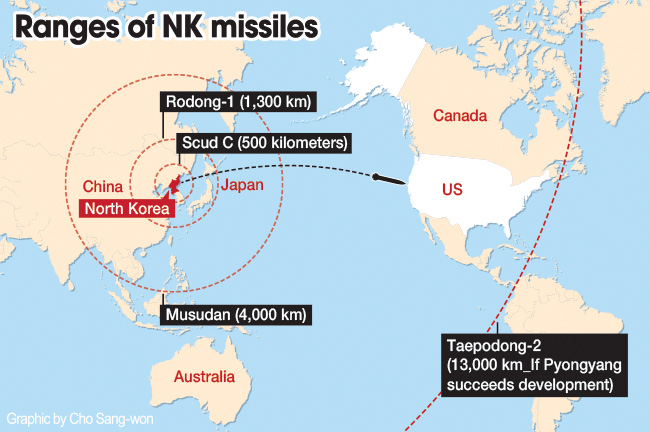- California Assembly OKs highest minimum wage in nation
- S. Korea unveils first graphic cigarette warnings
- US joins with South Korea, Japan in bid to deter North Korea
- LPGA golfer Chun In-gee finally back in action
- S. Korea won’t be top seed in final World Cup qualification round
- US men’s soccer misses 2nd straight Olympics
- US back on track in qualifying with 4-0 win over Guatemala
- High-intensity workout injuries spawn cottage industry
- CDC expands range of Zika mosquitoes into parts of Northeast
- Who knew? ‘The Walking Dead’ is helping families connect
NK rocket test is to hit any city in US mainland
By Yi Whan-woo
It is believed that North Korea may launch a rocket with a range of 13,000 kilometers (8,078 miles) during its purported satellite launch scheduled for later this month, according to analysts and officials, Wednesday.
It will likely be a three-stage rocket capable of carrying a satellite weighing up to one ton. If the test succeeds, North Korea could load a nuclear warhead onto the rocket that could theoretically hit a city on the U.S. mainland.
It remains to be seen whether the rocket can withstand heat of up to 7,000 degrees Celsius caused if it re-enters the Earth’s atmosphere after making it into outer space.
The re-entry phase of a rocket to the Earth’s atmosphere is essential as part of the inter-continental ballistic missile (ICBM) technologies that Pyongyang has pursued.
It is also questionable whether North Korea’s ICBM can hit a targeted area, most likely one on the U.S. mainland, even after it successfully re-enters the Earth’s atmosphere.
“It’s convincing to say that North Korea will fire a rocket that has longer travel distance than the Unha-3 rocket, which is believed to have a range of 10,000 kilometers,” said Yang Uk, a senior research fellow at the Korea Defense and Security Forum.
North Korea has continued to make progress in its rocket program since December 2012 when it launched the Unha-3 rocket.
Yang pointed out that the Kim Jong-un regime recently renovated the launch pad at its satellite launch station at Tongchang-ri, North Pyongan Province where the Unha-3 rocket was fired.
The launch pad is now 67 meters tall, up from 50 meters in December 2012.
“The height of a launch pad varies depending on the height of a rocket,” Yang said. “And the taller a rocket is, the farther it can travel.”
Kim Jong-dae, a military commentator, also said that the payload of a rocket increases if its height is taller.
“Given that the Unha-3 rocket had a payload of 150 kilograms, I think the rocket to be launched this month can carry up to 1 ton of material,” he said. “North Korea has repeatedly claimed it can miniaturize nuclear warheads, and if this is true, it means it may be able to load four nuclear warheads at the most this time.”
Kim and Yang joined military officials who remain skeptical about North Korea having technologies capable of building an ICBM that can endure the tremendous heat when re-entering the Earth’s atmosphere at high speed.
“It’s likely that North Korea will fire a modified version of KN-08,” Yang said, citing an ICBM that Pyongyang has been developing for years. “I wouldn’t raise any doubts about KN-08′s travel range of 13,000 kilometers but its endurance capability is a whole different story.”
Kin echoed a similar view.
“An ICBM will fall to the Earth at higher speed if its travel range is longer and consequently its flight in space longer,” he said.
“The control of speed is what makes a successful ICBM. And I believe North Korea mainly has focused on range in its rocket program.”
If the launch goes as planned, it is likely that the rocket’s first stage will fall in waters off the west coast of South Korea, and the second stage in waters east of the Philippines.
But it is not certain whether the rocket can accurately and ultimately reach an intended target, according to officials.
“North Korea’s divert and attitude control system (DACS), which plays a key role for a rocket or an ICMB to land on a targeted area, is still questionable,” an official said.

















